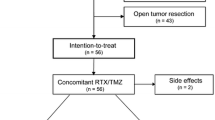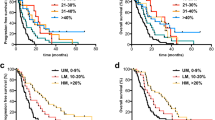Abstract
Epigenetic silencing of O-6-methylguanine-DNA methyltransferase (MGMT) promoter via methylation in a glioblastoma (GBM), has been correlated with a more favourable response to alkylating chemotherapeutic agents such as temozolomide. The use of global methylation surrogates such as Long Interspersed Nucleotide Element 1 (LINE1) may also be valuable in order to fully understand these highly heterogeneous tumours. In this study, we analysed both original and recurrent GBMs in 22 patients (i.e. 44 tumours), for both MGMT and LINE1 methylation status. In the 22 patients: 14 (63.6%) displayed MGMT methylation stability in the recurrent GBM versus 8 (36.4%), with instability of methylation status. No significant differences in overall and progression free survival was evident between these two groups. LINE1 methylation status remained stable for 12 (54.5%) of recurrent GBM patients versus 9 (41%) of the patients with instability in LINE1 methylation status (p = 0.02), resulting in an increase in overall survival of the stable LINE1 group (p = 0.04). The results obtained demonstrated major epigenetic instability of GBMs treated with temozolomide as part of the STUPP protocol. GBMs appear to undergo selective evolution post-treatment, and have the ability to recur with a newly reprogrammed epigenetic status. Selective targeting of the altered epigenomes in recurrent GBMs may facilitate the future development of both prognostic biomarkers and enhanced therapeutic strategies.




Similar content being viewed by others
References
Weller M, van den Bent M, Hopkins K, Tonn JC, Stupp R, Falini A (2014) EANO guideline for the diagnosis and treatment of anaplastic gliomas and glioblastoma. Lancet Oncol 15:e395–e403
Thakkar JP, Dolecek TA, Horbinski C, Ostrom QT, Lightner DD, Barnholtz-Sloan JS, Villano JL (2014) Epidemiologic and molecular prognostic review of glioblastoma. Cancer Epidemiol Biomarkers Prev 23(10):1985–1996
Stupp R, Hegi ME et al (2009) Effects of radiotherapy with concomitant and adjuvant temozolomide versus radiotherapy alone on survival in glioblastoma in a randomised phase III study: 5-year analysis of the EORTC-NCIC trial. Lancet Oncol 10(5):459–466
Donson AM, Addo-Yobo SO, Handler MH, Gore L, Foreman NK (2007) MGMT promoter methylation correlates with survival benefit and sensitivity to temozolomide in pediatric glioblastoma. Pediatr Blood Cancer 48(4):403–407
Dunn J, Baborie A, Alam F, Joyce K, Moxham M, Sibson R, Crooks D, Husband D, Shenoy A, Brodbelt A, Wong H, Liloglou T, Haylock B, Walker C (2009) Extent of MGMT promoter methylation correlates with outcome in glioblastomas given temozolomide and radiotherapy. Br J Cancer 101(1):124–131
Rulseh AM, Keller J, Klener J, Sroubek J, Dbalý V, Syrůček M, Tovaryš F, Vymazal J (2012) Long-term survival of patients suffering from glioblastoma multiforme treated with tumor-treating fields. World J Surg Oncol 10:220
Wang J, Cazzato E, Ladewig E, Frattini V, Rosenbloom DI, Zairis S, Abate F, Liu Z, Elliott O, Shin YJ, Lee JK, Lee IH, Park WY, Eoli M, Blumberg AJ, Lasorella A, Nam DH, Finocchiaro G, Iavarone A, Rabadan R (2016) Clonal evolution of glioblastoma under therapy. Nat Genet 48(7):768–776
Dang L, White DW, Gross S, Bennett BD, Bittinger MA, Driggers EM, Fantin VR, Jang HG, Jin S, Keenan MC, Marks KM, Prins RM, Ward PS, Yen KE, Liau LM, Rabinowitz JD, Cantley LC, Thompson CB, Vander Heiden MG, Su SM (2010) Cancer-associated IDH1 mutations produce 2-hydroxyglutarate. Nature 465(7300):966
Saharinen J, Taipale J, Monni O, Keski-Oja J (1998) Identification and characterization of a new latent transforming growth factor-beta-binding protein, LTBP-4. J Biol Chem 273(29):18459–18469
Yang AS, Estécio MR, Doshi K, Kondo Y, Tajara EH, Issa JP (2004) A simple method for estimating global DNA methylation using bisulfite PCR of repetitive DNA elements. Nucleic Acids Res 32(3):e38
Pearce MS, McConnell JC, Potter C, Barrett LM, Parker L, Mathers JC, Relton CL (2012) Global LINE-1 DNA methylation is associated with blood glycaemic and lipid profiles. Int J Epidemiol 41(1):210–217
Ohka F, Natsume A, Motomura K, Kishida Y, Kondo Y, Abe T, Nakasu Y, Namba H, Wakai K, Fukui T, Momota H, Iwami K, Kinjo S, Ito M, Fujii M, Wakabayashi T (2011) The global DNA methylation surrogate LINE-1 methylation is correlated with MGMT promoter methylation and is a better prognostic factor for glioma. PLoS ONE 6(8):e23332
Lee EJ, Rath P, Liu J, Ryu D, Pei L, Noonepalle SK, Shull AY, Feng Q, Litofsky NS, Miller DC, Anthony DC, Kirk MD, Laterra J, Deng L, Xin HB, Wang X, Choi JH, Shi H (2015) Identification of global DNA methylation signatures in glioblastoma-derived cancer stem cells. J Genet Genomics 42(7):355–371
Louis DN, Perry A, Reifenberger G, von Deimling A, Figarella-Branger D, Cavenee WK, Ohgaki H, Wiestler OD, Kleihues P, Ellison DW (2016 Jun) The 2016 World Health Organization classification of tumors of the central nervous system: a summary. Acta Neuropathol 131(6):803–820
Bender R, Lange S (2001) Adjusting for multiple testing–when and how? J Clin Epidemiol 54(4):343–349
Brandes AA, Franceschi E, Tosoni A, Blatt V, Pession A, Tallini G, Bertorelle R, Bartolini S, Calbucci F, Andreoli A, Frezza G, Leonardi M, Spagnolli F, Ermani M (2008) MGMT promoter methylation status can predict the incidence and outcome of pseudoprogression after concomitant radiochemotherapy in newly diagnosed glioblastoma patients. J Clin Oncol 26(13):2192–2197
Rivera AL, Pelloski CE, Gilbert MR, Colman H, De La Cruz C, Sulman EP, Bekele BN, Aldape KD (2010) MGMT promoter methylation is predictive of response to radiotherapy and prognostic in the absence of adjuvant alkylating chemotherapy for glioblastoma. Neuro Oncol 12(2):116–121
Weller M, Stupp R, Reifenberger G, Brandes AA, van den Bent MJ, Wick W, Hegi ME (2010) MGMT promoter methylation in malignant gliomas: ready for personalized medicine? Nat Rev Neurol 6(1):39–51
Brandes AA, Franceschi E, Tosoni A, Bartolini S, Bacci A, Agati R, Ghimenton C, Turazzi S, Talacchi A, Skrap M, Marucci G, Volpin L, Morandi L, Pizzolitto S, Gardiman M, Andreoli A, Calbucci F, Ermani M (2010) O(6)-methylguanine DNA-methyltransferase methylation status can change between first surgery for newly diagnosed glioblastoma and second surgery for recurrence: clinical implications. Neuro Oncol 12(3):283–288
Zhang J, Stevens MF, Bradshaw TD (2012) Temozolomide: mechanisms of action, repair and resistance. Curr Mol Pharmacol 5(1):102–114
Yan K, Yang K, Rich JN (2013) The evolving landscape of glioblastoma stem cells. Curr Opin Neurol 26(6):701–707
Deheeger M, Lesniak MS, Ahmed AU (2014) Cellular plasticity regulated cancer stem cell niche: a possible new mechanism of chemoresistance. Cancer Cell Microenviron 1(5):e295
Ma DJ, Galanis E, Anderson SK, Schiff D, Kaufmann TJ, Peller PJ, Giannini C, Brown PD, Uhm JH, McGraw S, Jaeckle KA, Flynn PJ, Ligon KL, Buckner JC, Sarkaria JN (2015) A phase II trial of everolimus, temozolomide, and radiotherapy in patients with newly diagnosed glioblastoma: NCCTG N057K. Neuro Oncol 17(9):1261–1269
Estécio MR, Gharibyan V, Shen L, Ibrahim AE, Doshi K, He R, Jelinek J, Yang AS, Yan PS, Huang TH, Tajara EH, Issa JP (2007) LINE-1 hypomethylation in cancer is highly variable and inversely correlated with microsatellite instability. PLoS ONE 2(5):e399
Xiao-Jie L, Hui-Ying X, Qi X, Jiang X, Shi-Jie M (2016) LINE-1 in cancer: multifaceted functions and potential clinical implications. Genet Med 18(5):431–439
Barciszewska AM, Gurda D, Głodowicz P, Nowak S, Naskręt-Barciszewska MZ (2015) A new epigenetic mechanism of temozolomide action in glioma cells. PLoS ONE 10(8):e0136669
Hsieh CH, Lee CH, Liang JA, Yu CY, Shyu WC (2010) Cycling hypoxia increases U87 glioma cell radioresistance via ROS induced higher and long-term HIF-1 signal transduction activity. Oncol Rep 24(6):1629–1636
Chen WL, Wang CC, Lin YJ, Wu CP, Hsieh CH (2015) Cycling hypoxia induces chemoresistance through the activation of reactive oxygen species-mediated B-cell lymphoma extra-long pathway in glioblastoma multiforme. J Transl Med 13:389
Molenaar RJ, Verbaan D, Lamba S, Zanon C, Jeuken JW, Boots-Sprenger SH, Wesseling P, Hulsebos TJ, Troost D, van Tilborg AA, Leenstra S, Vandertop WP, Bardelli A, van Noorden CJ, Bleeker FE (2014) The combination of IDH1 mutations and MGMT methylation status predicts survival in glioblastoma better than either IDH1 or MGMT alone. Neuro Oncol 16(9):1263–1273
Luo J, Li YN, Wang F, Zhang WM, Geng X (2010) S-adenosyl methionine inhibits the growth of cancer cells by reversing the hypomethylation status of c-myc and H-ras in human gastric cancer and colon cancer. Int J Biol Sci 6(7):784–795
Mathers JC (2005) Reversal of DNA hypomethylation by folic acid supplements: possible role in colorectal cancer prevention. Gut 54(5):579–581
Joung JG, Bae JS, Kim SC, Jung H, Park WY, Song SY (2016) Genomic characterization and comparison of multi-regional and pooled tumor biopsy specimens. PLoS ONE 11(3):e0152574
Smits M, van den Bent MJ (2017) Imaging correlates of adult glioma genotypes. Radiology 284(2):316–331
Author information
Authors and Affiliations
Corresponding author
Ethics declarations
Conflict of interest
None of the authors have any conflict of interest in relation to this work.
Rights and permissions
About this article
Cite this article
O’Regan, C.J., Kearney, H., Beausang, A. et al. Temporal stability of MGMT promoter methylation in glioblastoma patients undergoing STUPP protocol. J Neurooncol 137, 233–240 (2018). https://doi.org/10.1007/s11060-017-2722-3
Received:
Accepted:
Published:
Issue Date:
DOI: https://doi.org/10.1007/s11060-017-2722-3




